Analyzing Information Systems and ERP in Business Environments
VerifiedAdded on 2020/10/23
|14
|2730
|360
Report
AI Summary
This report delves into the realm of information systems and Enterprise Resource Planning (ERP) systems, crucial components for modern business operations. It begins by defining information systems and categorizing various types, including Decision Support Systems (DSS), Executive Information Systems (EIS), Management Information Systems (MIS), and Transaction Processing Systems (TPS), outlining their functions and managerial levels. The report then focuses on ERP systems, explaining their role in integrating various business functions like inventory management, human resources, and customer relationship management. It highlights the benefits of ERP systems, such as streamlined processes, improved data accuracy, reduced operational costs, and enhanced decision-making capabilities. The report also addresses the challenges associated with ERP implementation, such as budgeting issues and finding the right software. Finally, it offers recommendations for businesses looking to leverage information systems and ERP to improve efficiency and performance, emphasizing the importance of accurate data, data security, and choosing the right solutions to meet specific business goals. This report provides a detailed overview of information systems and ERP systems for business environments.
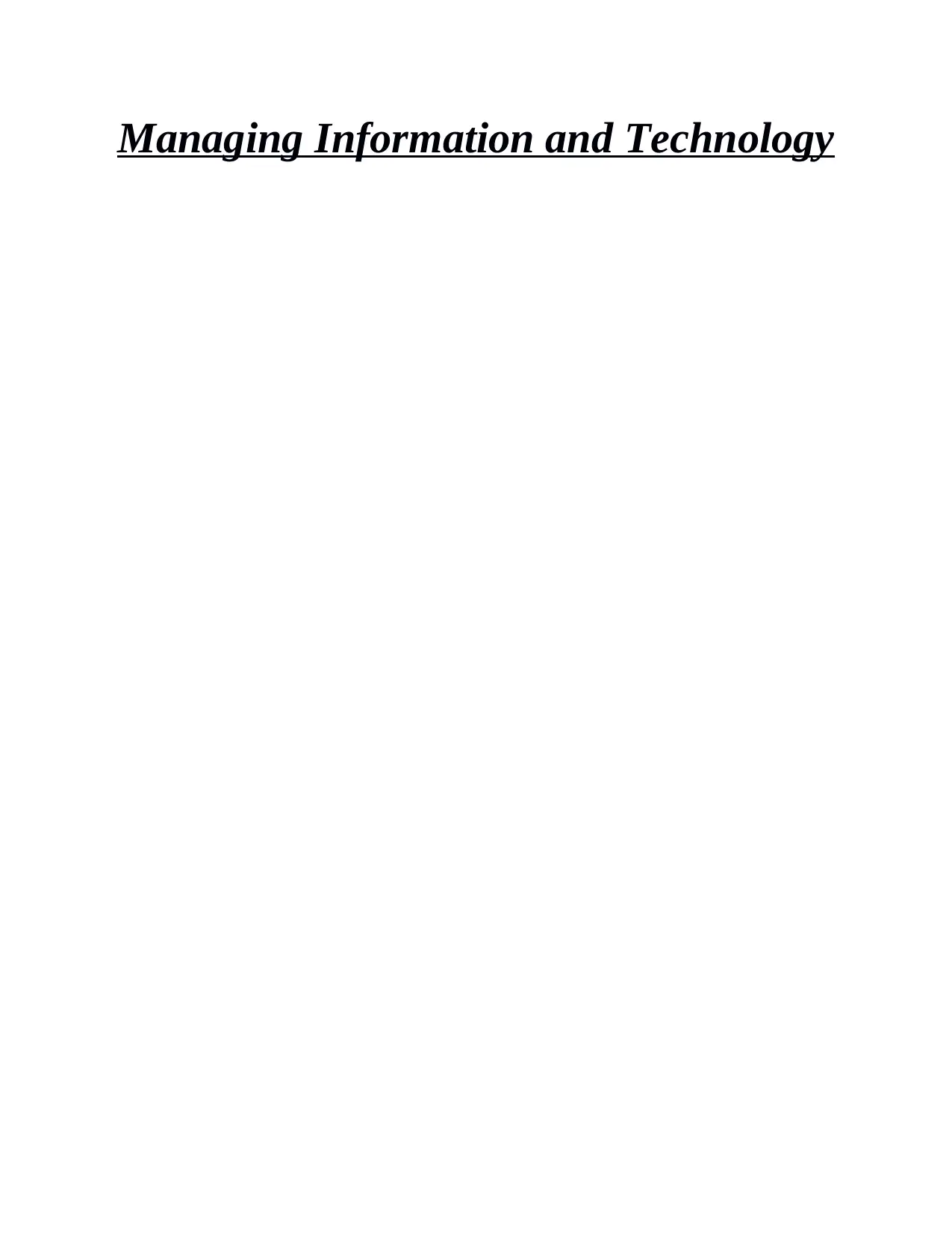
Managing Information and Technology
Paraphrase This Document
Need a fresh take? Get an instant paraphrase of this document with our AI Paraphraser
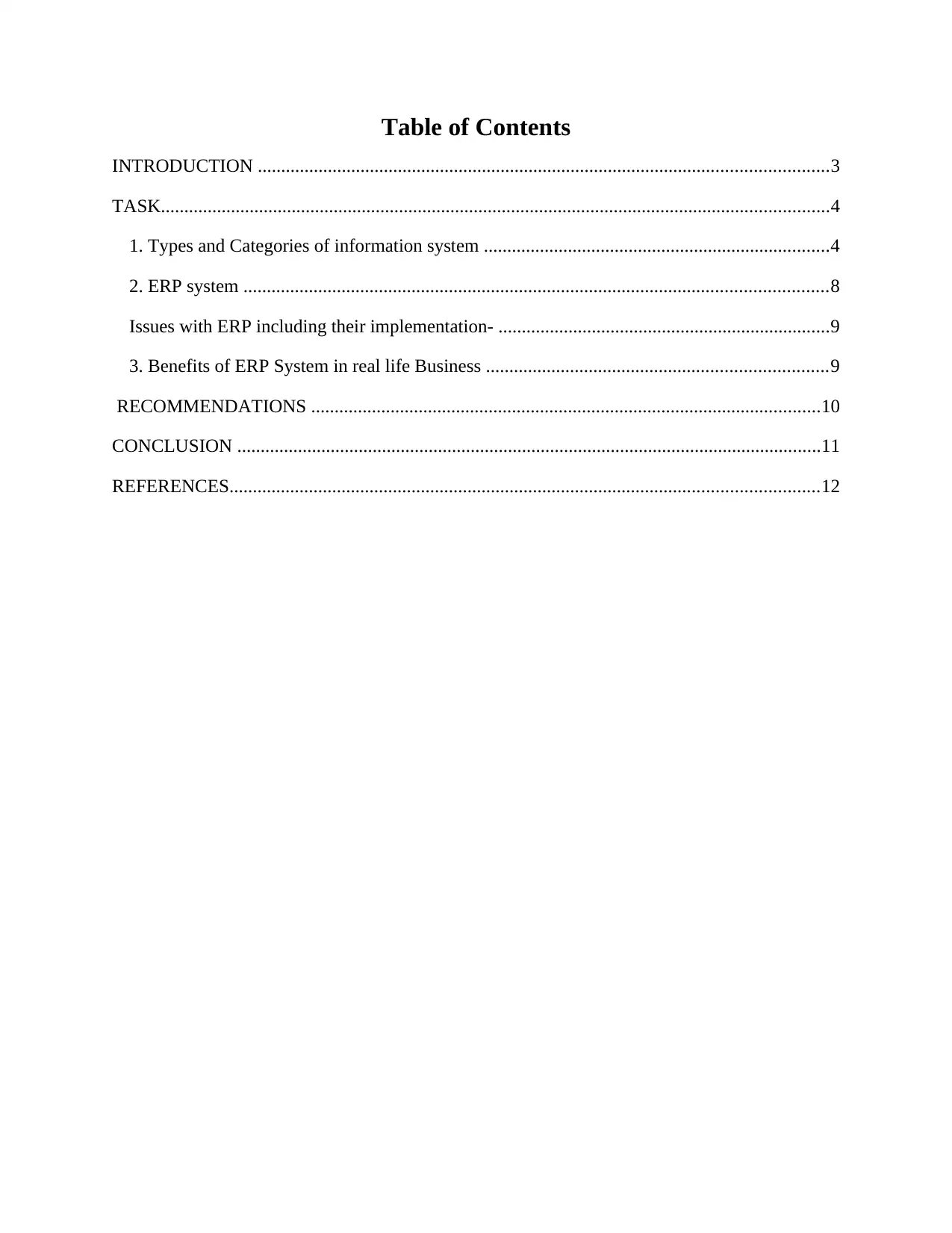
Table of Contents
INTRODUCTION ..........................................................................................................................3
TASK...............................................................................................................................................4
1. Types and Categories of information system ..........................................................................4
2. ERP system .............................................................................................................................8
Issues with ERP including their implementation- .......................................................................9
3. Benefits of ERP System in real life Business .........................................................................9
RECOMMENDATIONS .............................................................................................................10
CONCLUSION .............................................................................................................................11
REFERENCES..............................................................................................................................12
INTRODUCTION ..........................................................................................................................3
TASK...............................................................................................................................................4
1. Types and Categories of information system ..........................................................................4
2. ERP system .............................................................................................................................8
Issues with ERP including their implementation- .......................................................................9
3. Benefits of ERP System in real life Business .........................................................................9
RECOMMENDATIONS .............................................................................................................10
CONCLUSION .............................................................................................................................11
REFERENCES..............................................................................................................................12
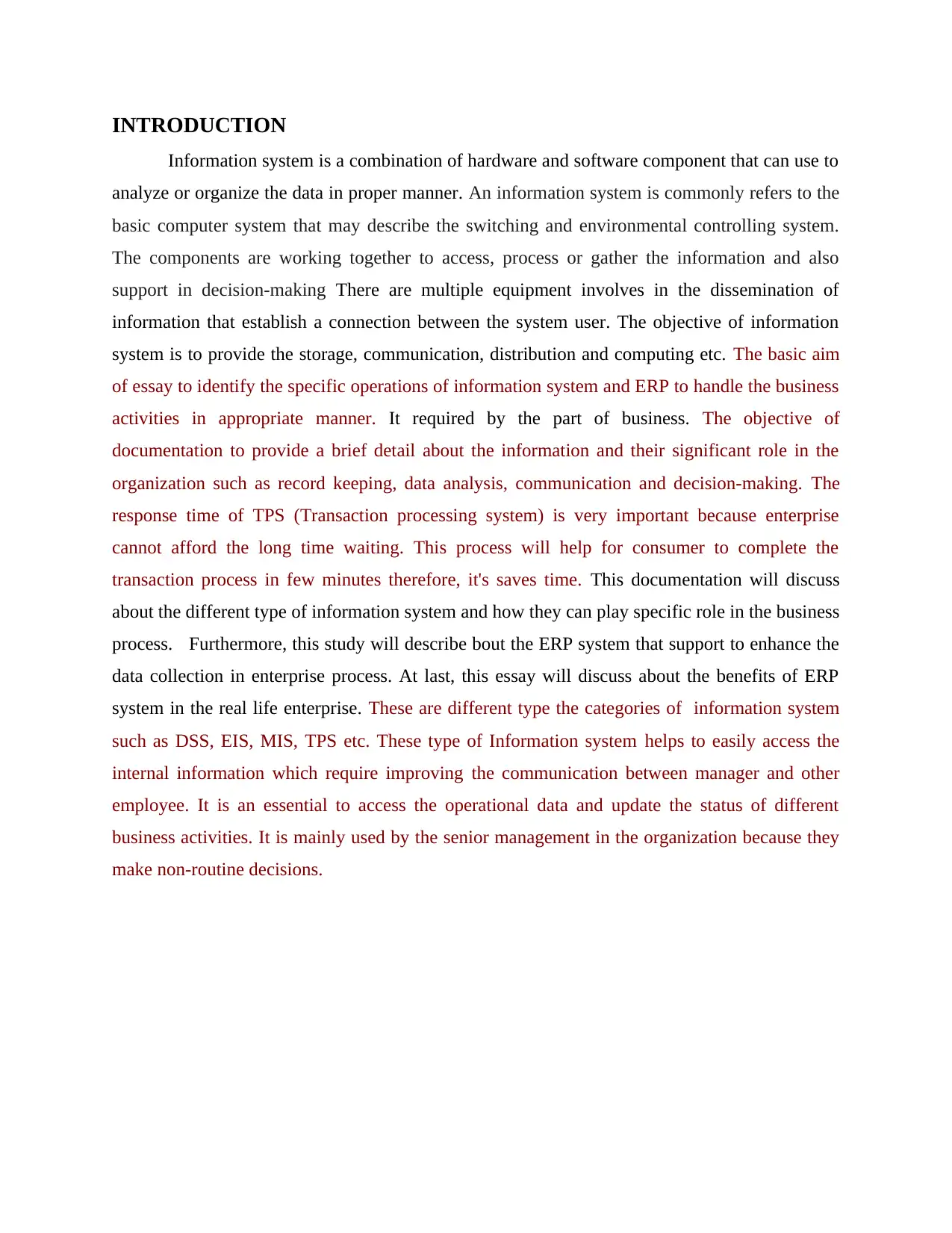
INTRODUCTION
Information system is a combination of hardware and software component that can use to
analyze or organize the data in proper manner. An information system is commonly refers to the
basic computer system that may describe the switching and environmental controlling system.
The components are working together to access, process or gather the information and also
support in decision-making There are multiple equipment involves in the dissemination of
information that establish a connection between the system user. The objective of information
system is to provide the storage, communication, distribution and computing etc. The basic aim
of essay to identify the specific operations of information system and ERP to handle the business
activities in appropriate manner. It required by the part of business. The objective of
documentation to provide a brief detail about the information and their significant role in the
organization such as record keeping, data analysis, communication and decision-making. The
response time of TPS (Transaction processing system) is very important because enterprise
cannot afford the long time waiting. This process will help for consumer to complete the
transaction process in few minutes therefore, it's saves time. This documentation will discuss
about the different type of information system and how they can play specific role in the business
process. Furthermore, this study will describe bout the ERP system that support to enhance the
data collection in enterprise process. At last, this essay will discuss about the benefits of ERP
system in the real life enterprise. These are different type the categories of information system
such as DSS, EIS, MIS, TPS etc. These type of Information system helps to easily access the
internal information which require improving the communication between manager and other
employee. It is an essential to access the operational data and update the status of different
business activities. It is mainly used by the senior management in the organization because they
make non-routine decisions.
Information system is a combination of hardware and software component that can use to
analyze or organize the data in proper manner. An information system is commonly refers to the
basic computer system that may describe the switching and environmental controlling system.
The components are working together to access, process or gather the information and also
support in decision-making There are multiple equipment involves in the dissemination of
information that establish a connection between the system user. The objective of information
system is to provide the storage, communication, distribution and computing etc. The basic aim
of essay to identify the specific operations of information system and ERP to handle the business
activities in appropriate manner. It required by the part of business. The objective of
documentation to provide a brief detail about the information and their significant role in the
organization such as record keeping, data analysis, communication and decision-making. The
response time of TPS (Transaction processing system) is very important because enterprise
cannot afford the long time waiting. This process will help for consumer to complete the
transaction process in few minutes therefore, it's saves time. This documentation will discuss
about the different type of information system and how they can play specific role in the business
process. Furthermore, this study will describe bout the ERP system that support to enhance the
data collection in enterprise process. At last, this essay will discuss about the benefits of ERP
system in the real life enterprise. These are different type the categories of information system
such as DSS, EIS, MIS, TPS etc. These type of Information system helps to easily access the
internal information which require improving the communication between manager and other
employee. It is an essential to access the operational data and update the status of different
business activities. It is mainly used by the senior management in the organization because they
make non-routine decisions.
⊘ This is a preview!⊘
Do you want full access?
Subscribe today to unlock all pages.

Trusted by 1+ million students worldwide
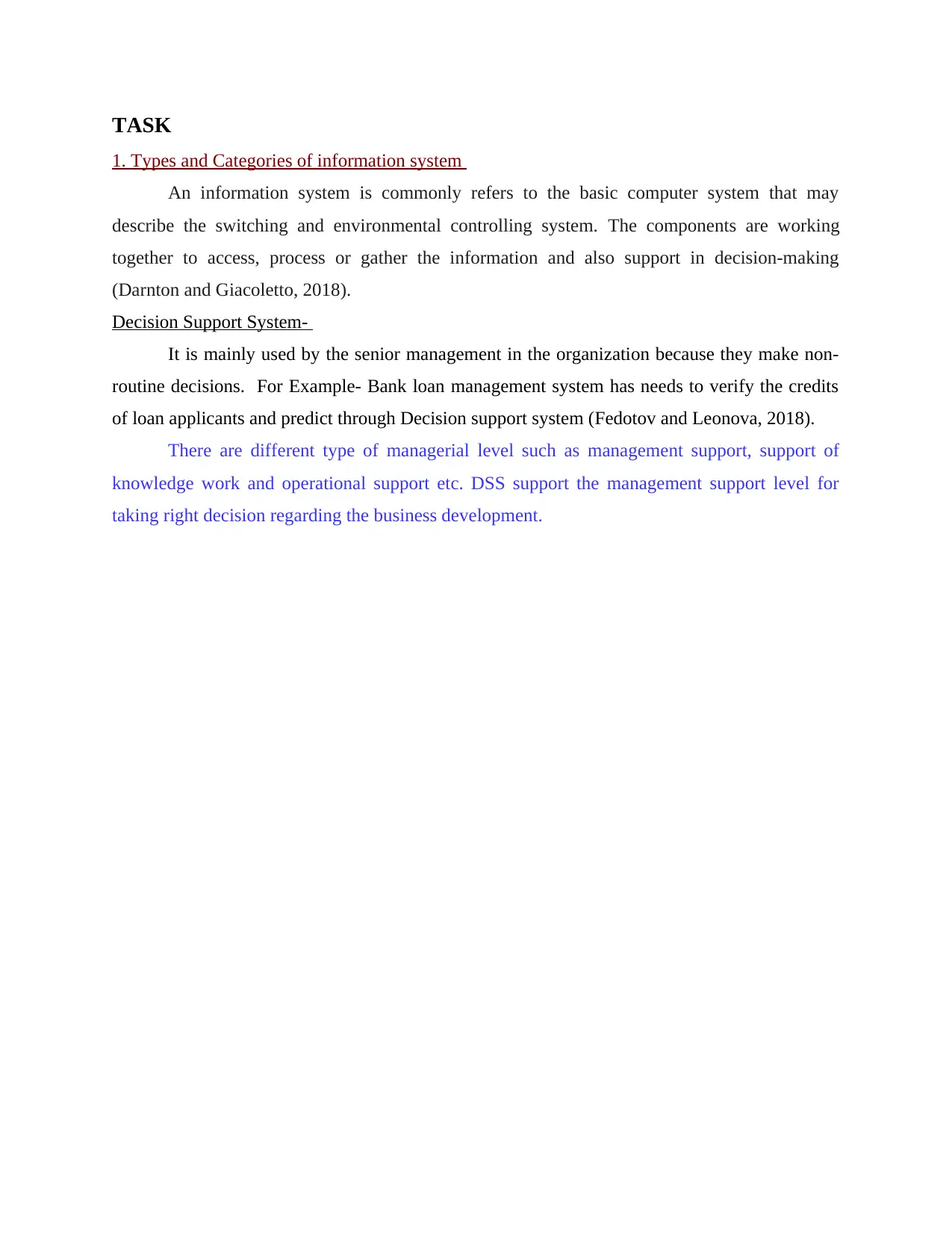
TASK
1. Types and Categories of information system
An information system is commonly refers to the basic computer system that may
describe the switching and environmental controlling system. The components are working
together to access, process or gather the information and also support in decision-making
(Darnton and Giacoletto, 2018).
Decision Support System-
It is mainly used by the senior management in the organization because they make non-
routine decisions. For Example- Bank loan management system has needs to verify the credits
of loan applicants and predict through Decision support system (Fedotov and Leonova, 2018).
There are different type of managerial level such as management support, support of
knowledge work and operational support etc. DSS support the management support level for
taking right decision regarding the business development.
1. Types and Categories of information system
An information system is commonly refers to the basic computer system that may
describe the switching and environmental controlling system. The components are working
together to access, process or gather the information and also support in decision-making
(Darnton and Giacoletto, 2018).
Decision Support System-
It is mainly used by the senior management in the organization because they make non-
routine decisions. For Example- Bank loan management system has needs to verify the credits
of loan applicants and predict through Decision support system (Fedotov and Leonova, 2018).
There are different type of managerial level such as management support, support of
knowledge work and operational support etc. DSS support the management support level for
taking right decision regarding the business development.
Paraphrase This Document
Need a fresh take? Get an instant paraphrase of this document with our AI Paraphraser

Issues:
It is difficult in quantifying all the data and information
Unaware about the assumptions
It failure the system design
Lack of technology knowledge in the users
Executive information System-
This type of management support system provide the facilities and support the senior
executive that can take important decision regarding the development. (Huang and et.al., 2018).
An executive information system is a specialized that can use the senior support from the
top level of managerial or management support system where senior level helping in the
decision-making and also planning for strategies for long term success.
There are several advantages such that Executive information system has developed to
support or manage the decision-making action towards the business process. This type of
information system is obtained the data from the different type of sources and aggregate or
display data in the form of resulting.
Issues:
It has a limited function and cannot perform complex calculations
It is very difficult to arrange
It is difficult in quantifying all the data and information
Unaware about the assumptions
It failure the system design
Lack of technology knowledge in the users
Executive information System-
This type of management support system provide the facilities and support the senior
executive that can take important decision regarding the development. (Huang and et.al., 2018).
An executive information system is a specialized that can use the senior support from the
top level of managerial or management support system where senior level helping in the
decision-making and also planning for strategies for long term success.
There are several advantages such that Executive information system has developed to
support or manage the decision-making action towards the business process. This type of
information system is obtained the data from the different type of sources and aggregate or
display data in the form of resulting.
Issues:
It has a limited function and cannot perform complex calculations
It is very difficult to arrange
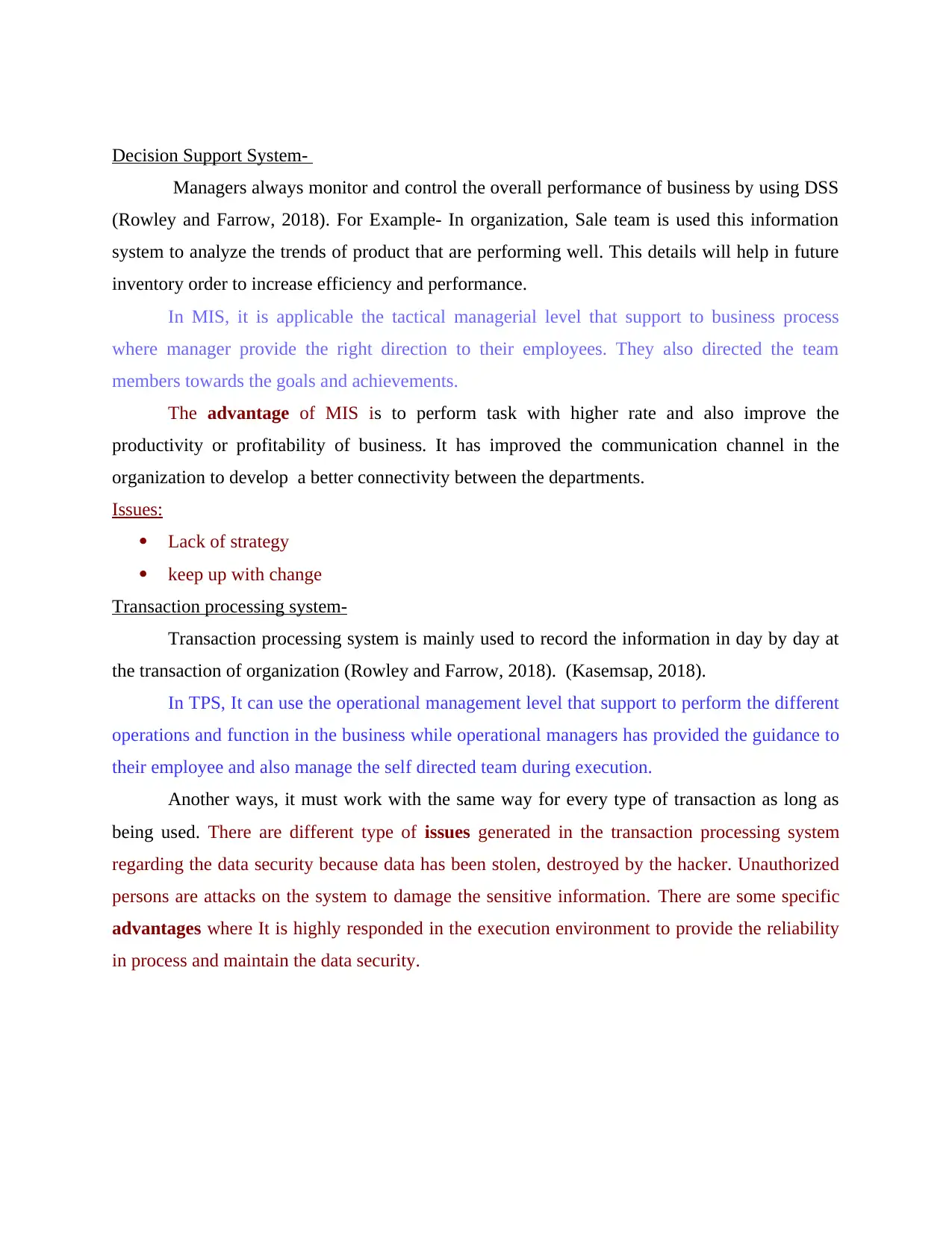
Decision Support System-
Managers always monitor and control the overall performance of business by using DSS
(Rowley and Farrow, 2018). For Example- In organization, Sale team is used this information
system to analyze the trends of product that are performing well. This details will help in future
inventory order to increase efficiency and performance.
In MIS, it is applicable the tactical managerial level that support to business process
where manager provide the right direction to their employees. They also directed the team
members towards the goals and achievements.
The advantage of MIS is to perform task with higher rate and also improve the
productivity or profitability of business. It has improved the communication channel in the
organization to develop a better connectivity between the departments.
Issues:
Lack of strategy
keep up with change
Transaction processing system-
Transaction processing system is mainly used to record the information in day by day at
the transaction of organization (Rowley and Farrow, 2018). (Kasemsap, 2018).
In TPS, It can use the operational management level that support to perform the different
operations and function in the business while operational managers has provided the guidance to
their employee and also manage the self directed team during execution.
Another ways, it must work with the same way for every type of transaction as long as
being used. There are different type of issues generated in the transaction processing system
regarding the data security because data has been stolen, destroyed by the hacker. Unauthorized
persons are attacks on the system to damage the sensitive information. There are some specific
advantages where It is highly responded in the execution environment to provide the reliability
in process and maintain the data security.
Managers always monitor and control the overall performance of business by using DSS
(Rowley and Farrow, 2018). For Example- In organization, Sale team is used this information
system to analyze the trends of product that are performing well. This details will help in future
inventory order to increase efficiency and performance.
In MIS, it is applicable the tactical managerial level that support to business process
where manager provide the right direction to their employees. They also directed the team
members towards the goals and achievements.
The advantage of MIS is to perform task with higher rate and also improve the
productivity or profitability of business. It has improved the communication channel in the
organization to develop a better connectivity between the departments.
Issues:
Lack of strategy
keep up with change
Transaction processing system-
Transaction processing system is mainly used to record the information in day by day at
the transaction of organization (Rowley and Farrow, 2018). (Kasemsap, 2018).
In TPS, It can use the operational management level that support to perform the different
operations and function in the business while operational managers has provided the guidance to
their employee and also manage the self directed team during execution.
Another ways, it must work with the same way for every type of transaction as long as
being used. There are different type of issues generated in the transaction processing system
regarding the data security because data has been stolen, destroyed by the hacker. Unauthorized
persons are attacks on the system to damage the sensitive information. There are some specific
advantages where It is highly responded in the execution environment to provide the reliability
in process and maintain the data security.
⊘ This is a preview!⊘
Do you want full access?
Subscribe today to unlock all pages.

Trusted by 1+ million students worldwide
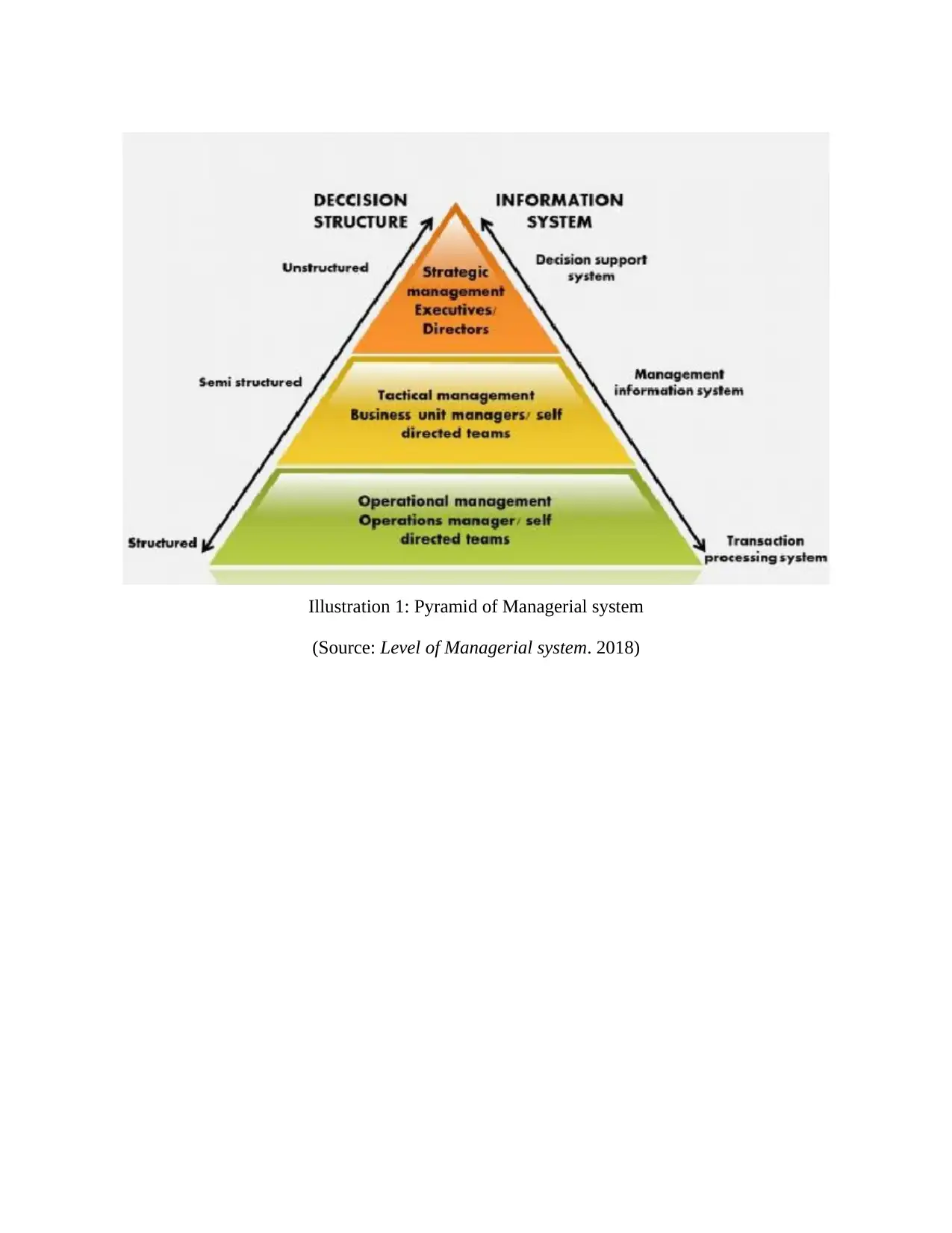
(Source: Level of Managerial system. 2018)
Illustration 1: Pyramid of Managerial system
Illustration 1: Pyramid of Managerial system
Paraphrase This Document
Need a fresh take? Get an instant paraphrase of this document with our AI Paraphraser
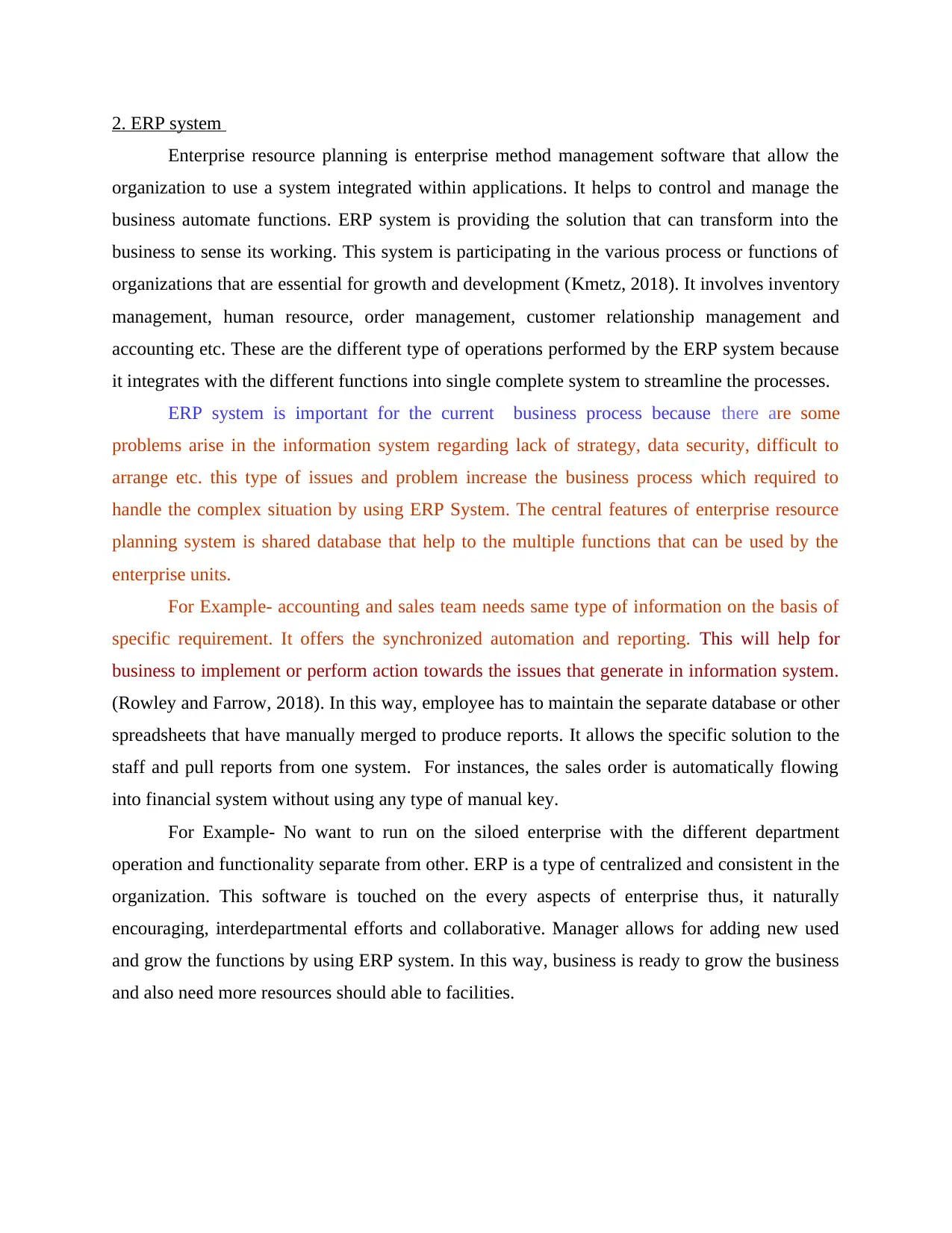
2. ERP system
Enterprise resource planning is enterprise method management software that allow the
organization to use a system integrated within applications. It helps to control and manage the
business automate functions. ERP system is providing the solution that can transform into the
business to sense its working. This system is participating in the various process or functions of
organizations that are essential for growth and development (Kmetz, 2018). It involves inventory
management, human resource, order management, customer relationship management and
accounting etc. These are the different type of operations performed by the ERP system because
it integrates with the different functions into single complete system to streamline the processes.
ERP system is important for the current business process because there are some
problems arise in the information system regarding lack of strategy, data security, difficult to
arrange etc. this type of issues and problem increase the business process which required to
handle the complex situation by using ERP System. The central features of enterprise resource
planning system is shared database that help to the multiple functions that can be used by the
enterprise units.
For Example- accounting and sales team needs same type of information on the basis of
specific requirement. It offers the synchronized automation and reporting. This will help for
business to implement or perform action towards the issues that generate in information system.
(Rowley and Farrow, 2018). In this way, employee has to maintain the separate database or other
spreadsheets that have manually merged to produce reports. It allows the specific solution to the
staff and pull reports from one system. For instances, the sales order is automatically flowing
into financial system without using any type of manual key.
For Example- No want to run on the siloed enterprise with the different department
operation and functionality separate from other. ERP is a type of centralized and consistent in the
organization. This software is touched on the every aspects of enterprise thus, it naturally
encouraging, interdepartmental efforts and collaborative. Manager allows for adding new used
and grow the functions by using ERP system. In this way, business is ready to grow the business
and also need more resources should able to facilities.
Enterprise resource planning is enterprise method management software that allow the
organization to use a system integrated within applications. It helps to control and manage the
business automate functions. ERP system is providing the solution that can transform into the
business to sense its working. This system is participating in the various process or functions of
organizations that are essential for growth and development (Kmetz, 2018). It involves inventory
management, human resource, order management, customer relationship management and
accounting etc. These are the different type of operations performed by the ERP system because
it integrates with the different functions into single complete system to streamline the processes.
ERP system is important for the current business process because there are some
problems arise in the information system regarding lack of strategy, data security, difficult to
arrange etc. this type of issues and problem increase the business process which required to
handle the complex situation by using ERP System. The central features of enterprise resource
planning system is shared database that help to the multiple functions that can be used by the
enterprise units.
For Example- accounting and sales team needs same type of information on the basis of
specific requirement. It offers the synchronized automation and reporting. This will help for
business to implement or perform action towards the issues that generate in information system.
(Rowley and Farrow, 2018). In this way, employee has to maintain the separate database or other
spreadsheets that have manually merged to produce reports. It allows the specific solution to the
staff and pull reports from one system. For instances, the sales order is automatically flowing
into financial system without using any type of manual key.
For Example- No want to run on the siloed enterprise with the different department
operation and functionality separate from other. ERP is a type of centralized and consistent in the
organization. This software is touched on the every aspects of enterprise thus, it naturally
encouraging, interdepartmental efforts and collaborative. Manager allows for adding new used
and grow the functions by using ERP system. In this way, business is ready to grow the business
and also need more resources should able to facilities.
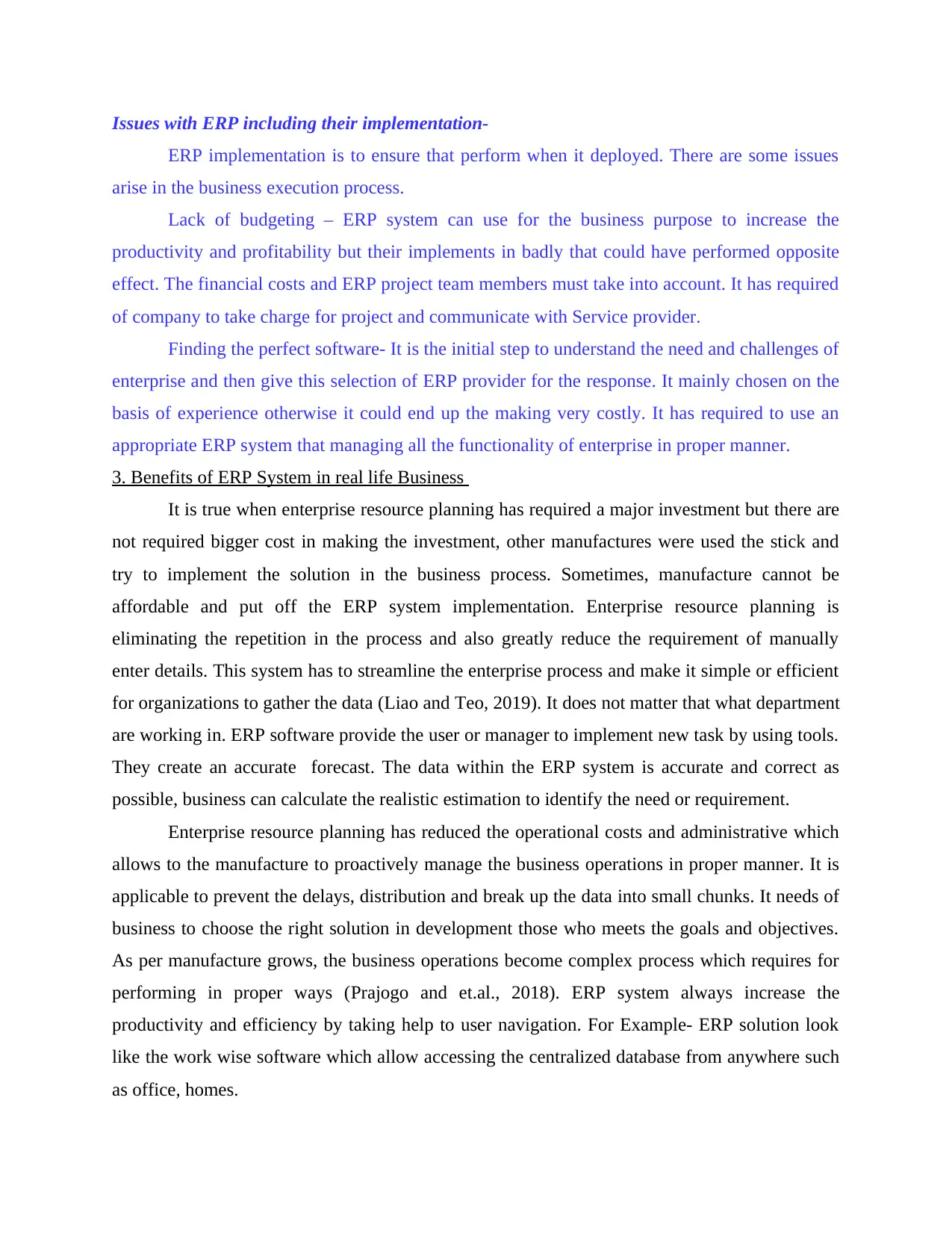
Issues with ERP including their implementation-
ERP implementation is to ensure that perform when it deployed. There are some issues
arise in the business execution process.
Lack of budgeting – ERP system can use for the business purpose to increase the
productivity and profitability but their implements in badly that could have performed opposite
effect. The financial costs and ERP project team members must take into account. It has required
of company to take charge for project and communicate with Service provider.
Finding the perfect software- It is the initial step to understand the need and challenges of
enterprise and then give this selection of ERP provider for the response. It mainly chosen on the
basis of experience otherwise it could end up the making very costly. It has required to use an
appropriate ERP system that managing all the functionality of enterprise in proper manner.
3. Benefits of ERP System in real life Business
It is true when enterprise resource planning has required a major investment but there are
not required bigger cost in making the investment, other manufactures were used the stick and
try to implement the solution in the business process. Sometimes, manufacture cannot be
affordable and put off the ERP system implementation. Enterprise resource planning is
eliminating the repetition in the process and also greatly reduce the requirement of manually
enter details. This system has to streamline the enterprise process and make it simple or efficient
for organizations to gather the data (Liao and Teo, 2019). It does not matter that what department
are working in. ERP software provide the user or manager to implement new task by using tools.
They create an accurate forecast. The data within the ERP system is accurate and correct as
possible, business can calculate the realistic estimation to identify the need or requirement.
Enterprise resource planning has reduced the operational costs and administrative which
allows to the manufacture to proactively manage the business operations in proper manner. It is
applicable to prevent the delays, distribution and break up the data into small chunks. It needs of
business to choose the right solution in development those who meets the goals and objectives.
As per manufacture grows, the business operations become complex process which requires for
performing in proper ways (Prajogo and et.al., 2018). ERP system always increase the
productivity and efficiency by taking help to user navigation. For Example- ERP solution look
like the work wise software which allow accessing the centralized database from anywhere such
as office, homes.
ERP implementation is to ensure that perform when it deployed. There are some issues
arise in the business execution process.
Lack of budgeting – ERP system can use for the business purpose to increase the
productivity and profitability but their implements in badly that could have performed opposite
effect. The financial costs and ERP project team members must take into account. It has required
of company to take charge for project and communicate with Service provider.
Finding the perfect software- It is the initial step to understand the need and challenges of
enterprise and then give this selection of ERP provider for the response. It mainly chosen on the
basis of experience otherwise it could end up the making very costly. It has required to use an
appropriate ERP system that managing all the functionality of enterprise in proper manner.
3. Benefits of ERP System in real life Business
It is true when enterprise resource planning has required a major investment but there are
not required bigger cost in making the investment, other manufactures were used the stick and
try to implement the solution in the business process. Sometimes, manufacture cannot be
affordable and put off the ERP system implementation. Enterprise resource planning is
eliminating the repetition in the process and also greatly reduce the requirement of manually
enter details. This system has to streamline the enterprise process and make it simple or efficient
for organizations to gather the data (Liao and Teo, 2019). It does not matter that what department
are working in. ERP software provide the user or manager to implement new task by using tools.
They create an accurate forecast. The data within the ERP system is accurate and correct as
possible, business can calculate the realistic estimation to identify the need or requirement.
Enterprise resource planning has reduced the operational costs and administrative which
allows to the manufacture to proactively manage the business operations in proper manner. It is
applicable to prevent the delays, distribution and break up the data into small chunks. It needs of
business to choose the right solution in development those who meets the goals and objectives.
As per manufacture grows, the business operations become complex process which requires for
performing in proper ways (Prajogo and et.al., 2018). ERP system always increase the
productivity and efficiency by taking help to user navigation. For Example- ERP solution look
like the work wise software which allow accessing the centralized database from anywhere such
as office, homes.
⊘ This is a preview!⊘
Do you want full access?
Subscribe today to unlock all pages.

Trusted by 1+ million students worldwide
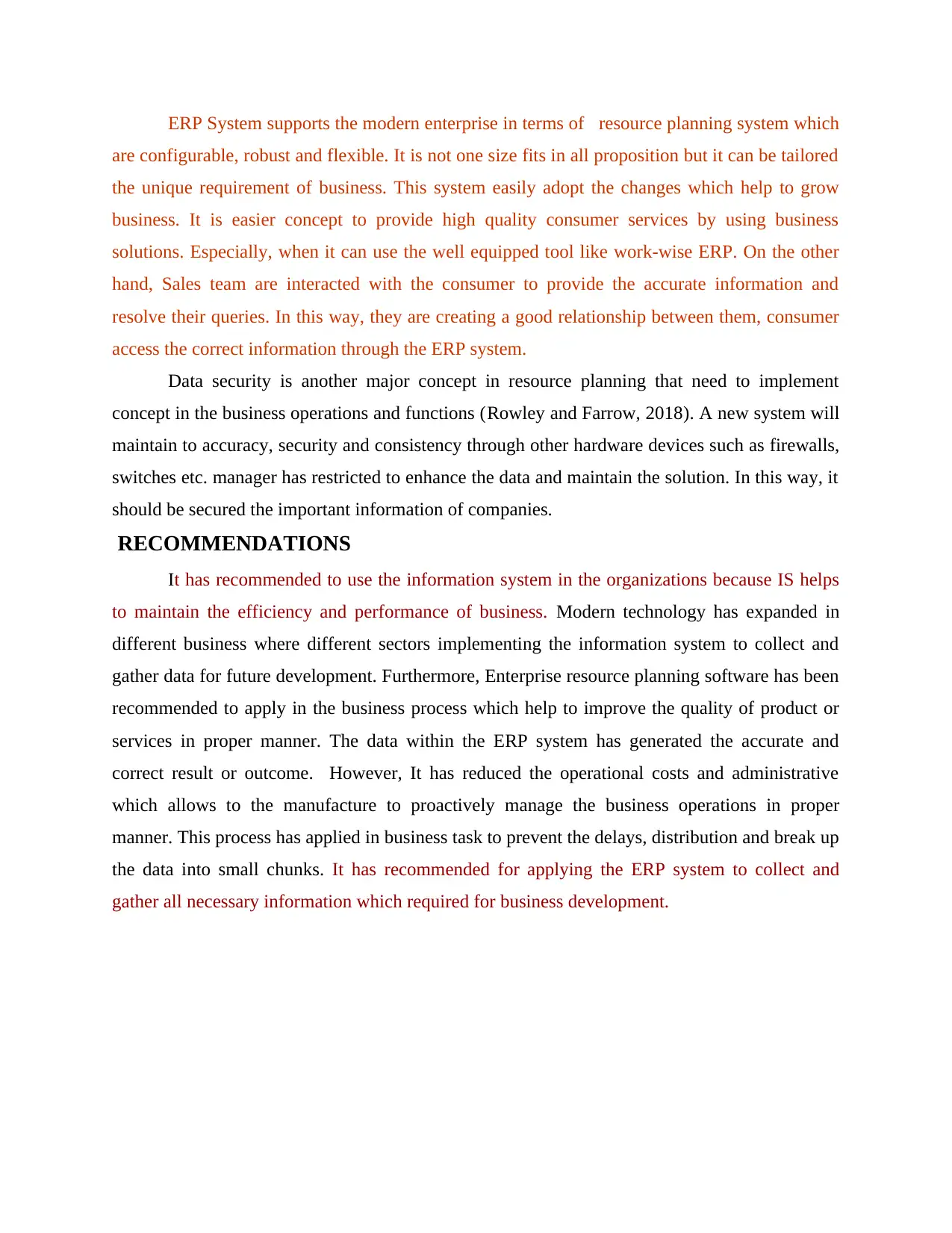
ERP System supports the modern enterprise in terms of resource planning system which
are configurable, robust and flexible. It is not one size fits in all proposition but it can be tailored
the unique requirement of business. This system easily adopt the changes which help to grow
business. It is easier concept to provide high quality consumer services by using business
solutions. Especially, when it can use the well equipped tool like work-wise ERP. On the other
hand, Sales team are interacted with the consumer to provide the accurate information and
resolve their queries. In this way, they are creating a good relationship between them, consumer
access the correct information through the ERP system.
Data security is another major concept in resource planning that need to implement
concept in the business operations and functions (Rowley and Farrow, 2018). A new system will
maintain to accuracy, security and consistency through other hardware devices such as firewalls,
switches etc. manager has restricted to enhance the data and maintain the solution. In this way, it
should be secured the important information of companies.
RECOMMENDATIONS
It has recommended to use the information system in the organizations because IS helps
to maintain the efficiency and performance of business. Modern technology has expanded in
different business where different sectors implementing the information system to collect and
gather data for future development. Furthermore, Enterprise resource planning software has been
recommended to apply in the business process which help to improve the quality of product or
services in proper manner. The data within the ERP system has generated the accurate and
correct result or outcome. However, It has reduced the operational costs and administrative
which allows to the manufacture to proactively manage the business operations in proper
manner. This process has applied in business task to prevent the delays, distribution and break up
the data into small chunks. It has recommended for applying the ERP system to collect and
gather all necessary information which required for business development.
are configurable, robust and flexible. It is not one size fits in all proposition but it can be tailored
the unique requirement of business. This system easily adopt the changes which help to grow
business. It is easier concept to provide high quality consumer services by using business
solutions. Especially, when it can use the well equipped tool like work-wise ERP. On the other
hand, Sales team are interacted with the consumer to provide the accurate information and
resolve their queries. In this way, they are creating a good relationship between them, consumer
access the correct information through the ERP system.
Data security is another major concept in resource planning that need to implement
concept in the business operations and functions (Rowley and Farrow, 2018). A new system will
maintain to accuracy, security and consistency through other hardware devices such as firewalls,
switches etc. manager has restricted to enhance the data and maintain the solution. In this way, it
should be secured the important information of companies.
RECOMMENDATIONS
It has recommended to use the information system in the organizations because IS helps
to maintain the efficiency and performance of business. Modern technology has expanded in
different business where different sectors implementing the information system to collect and
gather data for future development. Furthermore, Enterprise resource planning software has been
recommended to apply in the business process which help to improve the quality of product or
services in proper manner. The data within the ERP system has generated the accurate and
correct result or outcome. However, It has reduced the operational costs and administrative
which allows to the manufacture to proactively manage the business operations in proper
manner. This process has applied in business task to prevent the delays, distribution and break up
the data into small chunks. It has recommended for applying the ERP system to collect and
gather all necessary information which required for business development.
Paraphrase This Document
Need a fresh take? Get an instant paraphrase of this document with our AI Paraphraser
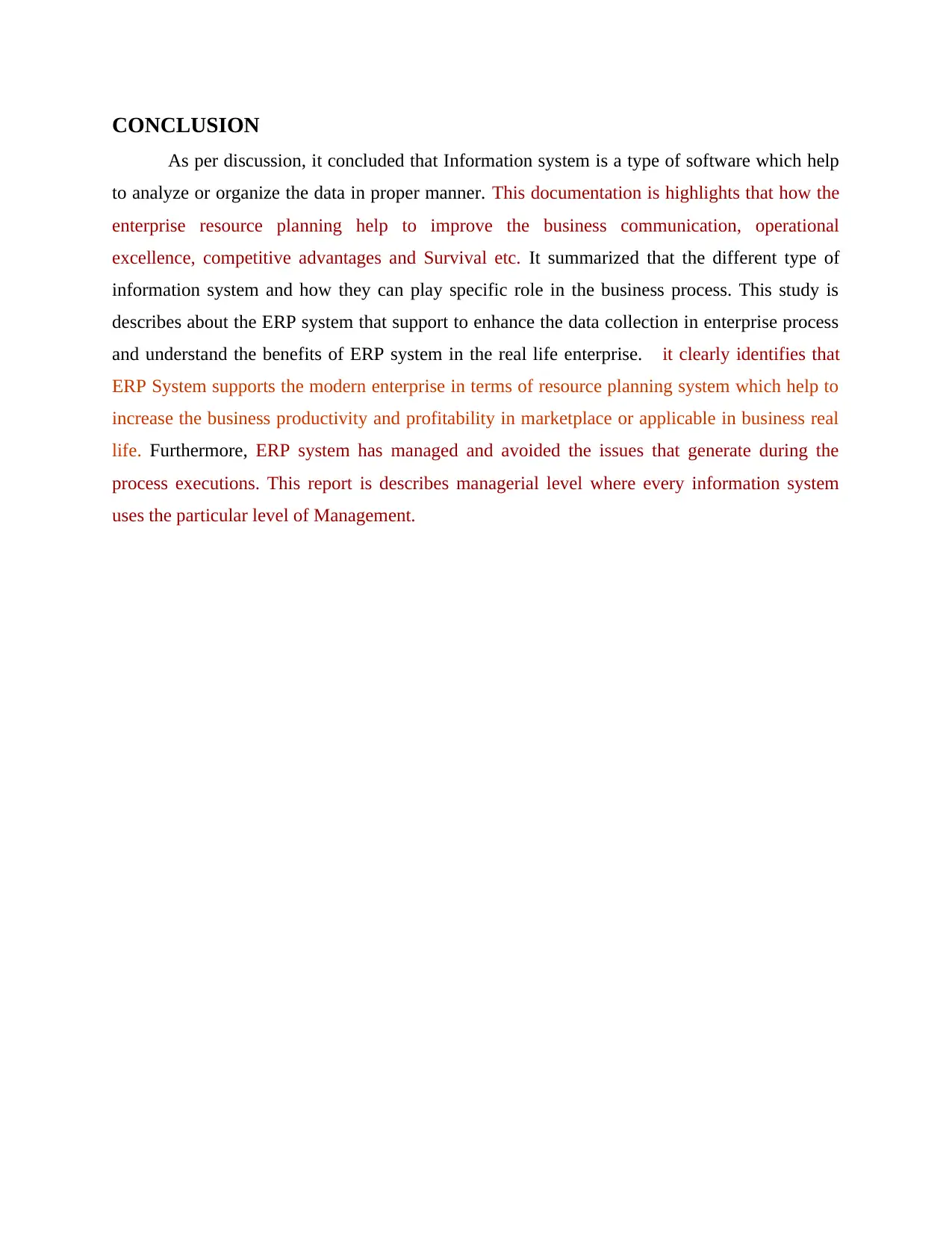
CONCLUSION
As per discussion, it concluded that Information system is a type of software which help
to analyze or organize the data in proper manner. This documentation is highlights that how the
enterprise resource planning help to improve the business communication, operational
excellence, competitive advantages and Survival etc. It summarized that the different type of
information system and how they can play specific role in the business process. This study is
describes about the ERP system that support to enhance the data collection in enterprise process
and understand the benefits of ERP system in the real life enterprise. it clearly identifies that
ERP System supports the modern enterprise in terms of resource planning system which help to
increase the business productivity and profitability in marketplace or applicable in business real
life. Furthermore, ERP system has managed and avoided the issues that generate during the
process executions. This report is describes managerial level where every information system
uses the particular level of Management.
As per discussion, it concluded that Information system is a type of software which help
to analyze or organize the data in proper manner. This documentation is highlights that how the
enterprise resource planning help to improve the business communication, operational
excellence, competitive advantages and Survival etc. It summarized that the different type of
information system and how they can play specific role in the business process. This study is
describes about the ERP system that support to enhance the data collection in enterprise process
and understand the benefits of ERP system in the real life enterprise. it clearly identifies that
ERP System supports the modern enterprise in terms of resource planning system which help to
increase the business productivity and profitability in marketplace or applicable in business real
life. Furthermore, ERP system has managed and avoided the issues that generate during the
process executions. This report is describes managerial level where every information system
uses the particular level of Management.

REFERENCES
Books and Journals
Darnton, G. and Giacoletto, S., 2018. Information in the Enterprise: it's more than technology.
Durotriges Press.
Fedotov, A.M. and Leonova, Y.V., 2018. Creation of a Prototype of a Scientific Information
System for Managing Information Resources. Data Analytics and Management in Data
Intensive Domains. pp.362-363.
Huang, C.D and et.al., 2018. Clinical Decision Support System for Managing COPD-Related
Readmission Risk. Information Systems Frontiers. pp.1-13.
Kasemsap, K., 2018. The roles of information technology and knowledge management in project
management metrics. In Global Business Expansion: Concepts, Methodologies, Tools,
and Applications (pp. 1191-1221). IGI Global.
Kmetz, J.L., 2018. The Information Processing Theory of Organization: Managing technology
accession in complex systems. Routledge.
Liao, L. and Teo, E.A.L., 2019. Managing critical drivers for building information modelling
implementation in the Singapore construction industry: an organizational change
perspective. International Journal of Construction M Level of Managerial system. 2018
anagement. 19(3). pp.240-256.
Prajogo, D and et.al., 2018. The relationships between information management, process
management and operational performance: Internal and external contexts. International
Journal of Production Economics. 199. pp.95-103.
Rowley, J.E. and Farrow, J., 2018. Organizing Knowledge: Introduction to Access to
Information: Introduction to Access to Information. Routledge.
Books and Journals
Darnton, G. and Giacoletto, S., 2018. Information in the Enterprise: it's more than technology.
Durotriges Press.
Fedotov, A.M. and Leonova, Y.V., 2018. Creation of a Prototype of a Scientific Information
System for Managing Information Resources. Data Analytics and Management in Data
Intensive Domains. pp.362-363.
Huang, C.D and et.al., 2018. Clinical Decision Support System for Managing COPD-Related
Readmission Risk. Information Systems Frontiers. pp.1-13.
Kasemsap, K., 2018. The roles of information technology and knowledge management in project
management metrics. In Global Business Expansion: Concepts, Methodologies, Tools,
and Applications (pp. 1191-1221). IGI Global.
Kmetz, J.L., 2018. The Information Processing Theory of Organization: Managing technology
accession in complex systems. Routledge.
Liao, L. and Teo, E.A.L., 2019. Managing critical drivers for building information modelling
implementation in the Singapore construction industry: an organizational change
perspective. International Journal of Construction M Level of Managerial system. 2018
anagement. 19(3). pp.240-256.
Prajogo, D and et.al., 2018. The relationships between information management, process
management and operational performance: Internal and external contexts. International
Journal of Production Economics. 199. pp.95-103.
Rowley, J.E. and Farrow, J., 2018. Organizing Knowledge: Introduction to Access to
Information: Introduction to Access to Information. Routledge.
⊘ This is a preview!⊘
Do you want full access?
Subscribe today to unlock all pages.

Trusted by 1+ million students worldwide
1 out of 14
Related Documents
Your All-in-One AI-Powered Toolkit for Academic Success.
+13062052269
info@desklib.com
Available 24*7 on WhatsApp / Email
![[object Object]](/_next/static/media/star-bottom.7253800d.svg)
Unlock your academic potential
Copyright © 2020–2025 A2Z Services. All Rights Reserved. Developed and managed by ZUCOL.





